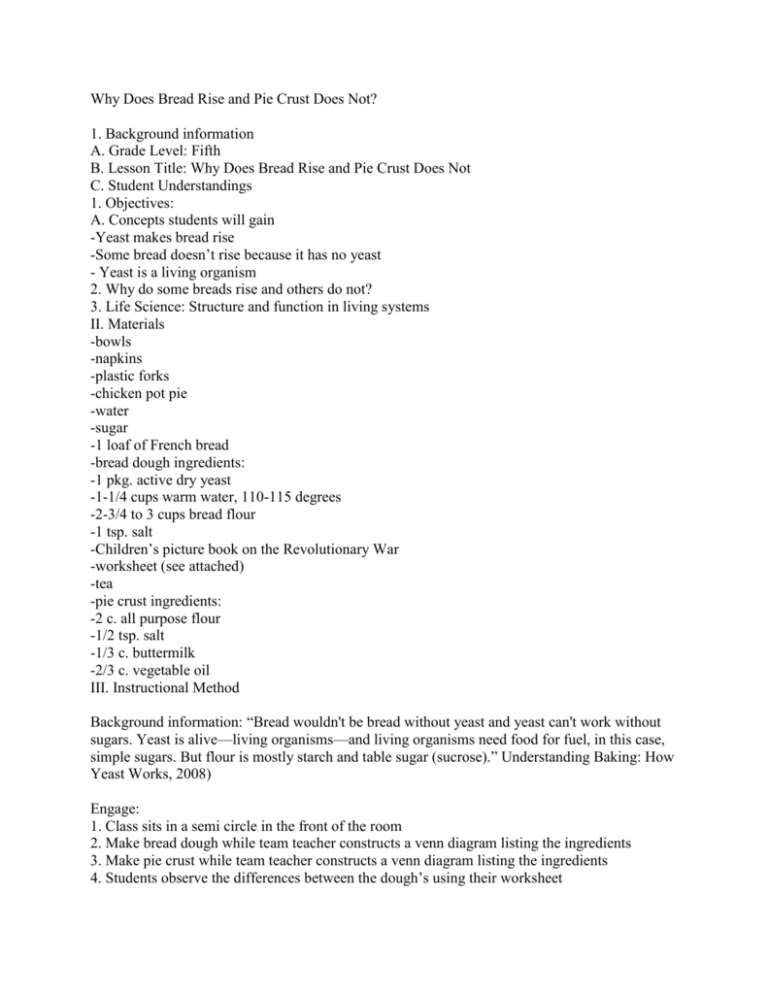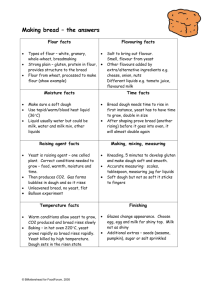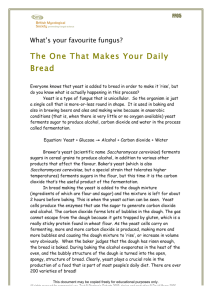Why Does Bread Rise and Pie Crust Does Not
advertisement

Why Does Bread Rise and Pie Crust Does Not? 1. Background information A. Grade Level: Fifth B. Lesson Title: Why Does Bread Rise and Pie Crust Does Not C. Student Understandings 1. Objectives: A. Concepts students will gain -Yeast makes bread rise -Some bread doesn’t rise because it has no yeast - Yeast is a living organism 2. Why do some breads rise and others do not? 3. Life Science: Structure and function in living systems II. Materials -bowls -napkins -plastic forks -chicken pot pie -water -sugar -1 loaf of French bread -bread dough ingredients: -1 pkg. active dry yeast -1-1/4 cups warm water, 110-115 degrees -2-3/4 to 3 cups bread flour -1 tsp. salt -Children’s picture book on the Revolutionary War -worksheet (see attached) -tea -pie crust ingredients: -2 c. all purpose flour -1/2 tsp. salt -1/3 c. buttermilk -2/3 c. vegetable oil III. Instructional Method Background information: “Bread wouldn't be bread without yeast and yeast can't work without sugars. Yeast is alive—living organisms—and living organisms need food for fuel, in this case, simple sugars. But flour is mostly starch and table sugar (sucrose).” Understanding Baking: How Yeast Works, 2008) Engage: 1. Class sits in a semi circle in the front of the room 2. Make bread dough while team teacher constructs a venn diagram listing the ingredients 3. Make pie crust while team teacher constructs a venn diagram listing the ingredients 4. Students observe the differences between the dough’s using their worksheet 5. Students predict what will happen to each when they are cooked and why using their worksheet 6. Bring out finished products after they are cooked 7. Students hypothesize why it happened 8. Class compares the ingredients in the two samples Explore: 1. Class observes yeast under the microscope first with water only then with sugar added -Have class predict what they might see before and collect data during each experiment one the worksheet provided. Explain: 1. Ask what did you notice? 2. Ask students to share their results from the investigation 3. Collect student’s data of what made the yeast multiply faster Evaluate: 1. Hand out one slice of bread, a cup of tea, and a piece of pie to each student as the other teachers read the book 2. Discuss what foods were eaten during the Revolutionary War - The book we chose is titled You Wouldn’t Want to be at the Boston Tea Party! Wharf Water Tea You’d Rather Not Drink. Use connections to tie together the tea they’re drinking to: -Tea was in short supply -What social class would we be in since we drink our tea out of paper cups? -The Sons of Liberty stole 342 tea chests full of British tea from ships importing into the Boston Harbor -Why do you think we chose to eat this food? -What other foods do you think they ate during the colonial times? IV. Assessment: 1. Students will write a five-sentence summary on yeast. References Understanding Baking: How Yeast Works, (2008) http://www.foodreference.com/html/yeast-how-works-729.html. Cook, P. (2006). You Wouldn’t Want to be at the Boston Tea Party! Wharf Water Tea You’d Rather Not Drink. New York: Scholastic.

